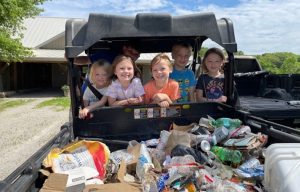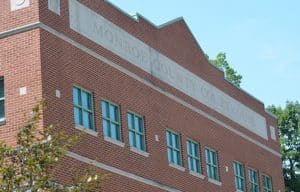In memory of brothers in arms

Fremont Granade’s marker at the Waterloo Cemetery.
Just what does Memorial Day mean? Is it a day of veterans and families gathering at cemeteries around the country? Is it a day for barbecues? Is it the unofficial opening day of summer?
It’s all those things.
It’s a federal holiday observed on the last Monday of May to remember all those who have died in our nation’s wars.
Take World War II, for example. At the start of U.S. involvement in WWII the nation’s population was 133.4 million. Some 12.1 million – mostly men – donned American uniforms to serve. The death toll came to 405,399. Countless other men and women worked in war industries or farmed to feed the nation and world during WWII.
Those numbers are nearly impossible to grasp in a meaningful way.
One Valmeyer family experienced the grand scale of the war on a personal and tragic scale. Two boys who grew up as brothers died eight months and more than 10,000 miles apart.
They are Elwood Meyer and Fremont Granade. Both attended Valmeyer High School. Elwood was 28 when he gave his life; Fremont was 22. Valmeyer was a tiny, close-knit rural community with a population of 591 in 1940.

Elwood Meyer’s marker at the Ss. Peter & Paul Catholic Cemetery, Waterloo.
Elwood was born Aug. 14, 1915, the son of Alfred Meyer. His mother passed away when he was young, and his father remarried Carrie Granade, who brought her son Fremont, born Sept. 13, 1922, from a previous marriage, to the family.
There isn’t a lot of information on the service of the two boys. A huge fire at the National Personnel Records Center in St. Louis in 1973 destroyed much of the Army’s records from 1912 through 1959.
What is known is a credit to the diligent search of Richard and Terri Moore of Indiana. Richard is a distant relative of Elwood and Fremont, and he’s passionate about sustaining their memories. He even continues the aviation tradition of Elwood and Fremont, who served in the Army Air Corps, as a Boeing 767 pilot flying international routes for United Parcel Service.
Elwood and Fremont both enlisted early in the war, when its outcome was rankly uncertain at best. The older brother, Elwood, would in fact raise his right hand on Dec. 29, 1941 – only three weeks after the attack on Pearl Harbor. Fremont followed on Nov. 4, 1942. Both enlisted in the U.S. Army Air Corps – the precursor to today’s U.S. Air Force.
Thanks to the Moores, we know Elwood was first sent to the Pacific Theater, with the 19th Bomb Squadron in Australia, serving in B-17 heavy bombers as a gunner. He was transferred forward to Papua, New Guinea, with another aviation unit, the 43rd Bomb Group, 64thSquadron, this time with B-26 medium bombers, as a gunner. And there, on either July 1 or 2, 1943, he was killed. Records missing as they are, his cause of death is uncertain. But they indicate it was due to an accidental weapon discharge. Family members have told Richard they thought Elwood may have stepped on a land mine.

This photo is believed to show the final moments of the B-17 bomber “Passionate Witch II,” which was shot down by German anti-aircraft fire over France on March 28, 1944.
Fremont’s service is better documented. He was sent to Europe, to the 452nd Bomb Group, 728th Squadron, at Deopham Green, England. There, like his brother, he was assigned as a gunner in B-17 heavy bombers.
On only his fourth mission, flying in a bomber named the “Passionate Witch II,” on March 28, 1944, his plane was shot down by German anti-aircraft fire over Chateaudun Air Field in France. The bomber was hit in the gas tank and its right wing and outer engine were ripped off in an explosion. A photograph taken from another plane is thought to show the plane in its death plunge, flames erupting.
Three men jumped from the “Passionate Witch II,” but Fremont wasn’t one of them. In fact, one document indicates he might not have even had his parachute on. This would not have been unusual, as the cramped confines of a bomber made it difficult to move around while encumbered with a bulky parachute and other gear.
Richard and Terri traveled to France last August to experience the honors the French continue to extend annually to all who served to liberate that country.
One of the hardest parts of service during those days was the lack of communication with those at home. It made the miles seem much further. Letters and packages might take weeks and even months to travel to service members overseas. Mail took a back seat to ammunition, repair parts and food.
Families first received telegrams noting a person as Missing in Action, or “MIA.” These were followed by telegrams indicating Killed in Action, or “KIA.” These telegrams were terse and seldom conveyed much information.

Every year the French continue to honor the Americans who fought and died to liberate their country during WWII. Pictured, a group of French re-enactors pose in front of a plaque dedicated to crews of two B-17 bombers who died during a raid on the heavily defended German airfield at Chateaudun, France. Fremont Granade’s name is listed fifth from the top.
Another hard fact was that again, due to priorities for transportation, the numbers of bodies, as well as situations overseas, remains were not promptly returned home as they usually are today. In fact, Elwood’s remains didn’t come home from New Guinea until March 3, 1948, when he was interred at Ss. Peter & Paul Catholic Cemetery in Waterloo. Fremont was returned from France and buried in the Waterloo Cemetery on Nov. 6, 1948.
A tradition began in America during World War I designating “Gold Star Mothers, or Families,” as ones who had lost children in military service. The designation was indicated by the presence of a flag to be displayed in the window of a home. It was a vertical format, with a heavy red border around a white field with a gold star in the middle.
Elwood and Fremont’s family would probably have had two such sad flags in their window in Valmeyer – hardly a fair compensation for the loss of two children. And while neither brother wised for his fate, they both gave their lives in total dedication, first to this country’s survival and then victory.
So, that’s what Memorial Day means. It’s a time to enjoy with families and eat a good meal as well. It marks the unofficial advent of summer, so plan a good one.
But it also deserves the consideration of those who have made these joyful times possible.
On Memorial Day, the focus is centered on those who gave their lives and their families who suffered their losses. A moment of silence for them will be deeply appreciated.

Gold Star Service Banners were given to the families of fallen soldiers.
Memorial Day services
There are services planned in Waterloo, Columbia, Hecker and Valmeyer on Monday as part of Memorial Day.
The Waterloo VFW and Waterloo American Legion are hosting a program on the Monroe County Courthouse lawn starting at 11 a.m. Monday.
Columbia will recognize Vietnam War veterans during their Memorial Day program, which will begin at 10 a.m. Monday at the Columbia American Legion hall.
The Hecker Memorial Day program will take place 10 a.m. Monday at St. Augustine’s Catholic Cemetery, featuring a dove release, air show and patriotic motorcycle parade.
Valmeyer American Legion Post 901 will hold Memorial Day services at 10 a.m. Monday at the Legion post.








